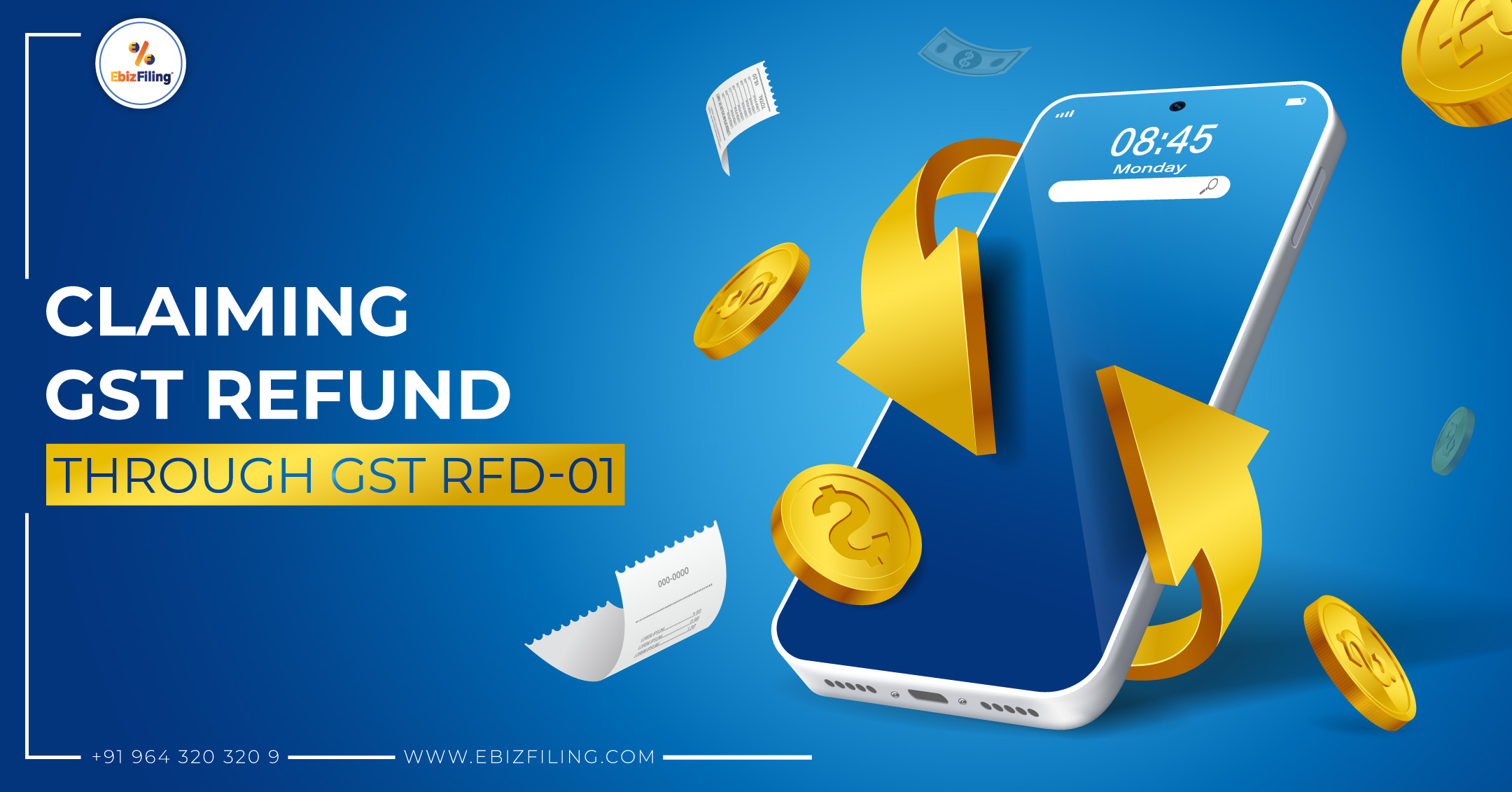
-
August 17, 2023
How to claim a refund through GST RFD-01? A Step-by-Step Guide
Introduction
The implementation of the Goods and Services Tax (GST) in India has significantly transformed the taxation system, simplifying it and promoting a unified approach. While GST has streamlined various aspects of taxation, there are instances where taxpayers become eligible for refunds. In order to facilitate a smooth and efficient refund process, the Goods and Services Tax Network (GSTN) has introduced the GST RFD-01 form. This form plays a crucial role in enabling taxpayers to claim refunds and ensures compliance with the GST regulations. In this article, we will provide a comprehensive step-by-step guide on how to claim a refund through the GST RFD-01 form, allowing taxpayers to navigate the process with ease and accuracy.
What is GST RFD-01?
GST RFD-01 is a refund application form under the Goods and Services Tax regime. It serves as the primary document through which taxpayers can claim a refund for any excess tax paid, accumulated input tax credit, or exports made. The form is designed to capture essential details and information related to the refund claim, making it easier for authorities to process and verify the claim.
The introduction of the GST RFD-01 form has significantly simplified the refund procedure, eliminating the need for complex paperwork and ensuring a more efficient and transparent process. By standardizing the refund application process, the form promotes uniformity and reduces discrepancies, thereby enhancing the overall taxpayer experience.
What are the Key Components of GST RFD-01?
1. Personal and Business Information: The form requires the taxpayer to provide accurate personal details, including the name, address, and contact information. Additionally, business-related information such as the Goods and Services Tax Identification Number (GSTIN), legal name, and trade name must be provided.
2. Refund Type: Taxpayers need to specify the type of refund they are claiming. This could include excess tax paid, accumulated input tax credit, or refunds related to exports.
3. Tax Period: The form requires taxpayers to mention the tax period for which the refund is being claimed. This ensures that the refund claim corresponds to the relevant period and avoids any confusion during the verification process.
4. Supporting Documents: As part of the refund claim, taxpayers must attach relevant supporting documents to substantiate their claim. These may include invoices, shipping bills, export invoices, bank statements, or any other documents specific to the nature of the refund claim.
5. Computation of Refund Amount: Taxpayers must provide an accurate computation of the refund amount claimed. This includes details such as the tax amount, interest, penalties (if any), and the net refund amount sought.
6. Bank Account Details: It is essential to provide accurate bank account details, including the account number, IFSC code, and branch name. This ensures that the refund amount is directly credited to the taxpayer’s bank account.
What is the procedure to claim a refund through GST RFD-01?
Procedure to Claim a Refund through GST RFD-01:
Step 1: Registration on GST Portal
To initiate the refund claim process, ensure that you are registered on the GST Portal (www.gst.gov.in). If you haven’t registered yet, complete the registration process by providing the necessary details and obtaining your unique Goods and Services Tax Identification Number (GSTIN).
Step 2: Accessing the GST RFD-01 Form
Log in to the GST Portal using your credentials. Once logged in, navigate to the ‘Services’ tab and click on ‘Refunds.’ From the dropdown menu, select ‘Application for Refund’ and choose the ‘GST RFD-01’ form.
Step 3: Filling the Form
The GST RFD-01 form consists of several sections that need to be completed accurately. Provide your personal and business details, including the GSTIN, legal name, trade name, and contact information.
Step 4: Selecting the Refund Type
In this section, specify the type of refund you are claiming. The options include a refund of excess tax paid, accumulated input tax credit, or refunds related to exports. Choose the appropriate option that aligns with your refund claim.
Step 5: Mentioning the Tax Period
Indicate the specific tax period for which the refund is being claimed. It is crucial to mention the correct tax period to ensure alignment with the relevant transaction details and corresponding tax liabilities.
Step 6: Attaching Supporting Documents
Attach the necessary supporting documents to substantiate your refund claim. The documents required may vary based on the type of refund being claimed. Examples of supporting documents include invoices, shipping bills, export invoices, bank statements, or any other relevant documents that validate the refund claim.
Step 7: Computation of Refund Amount
Provide an accurate computation of the refund amount you are claiming. This section should include details such as the tax amount, interest, penalties (if applicable), and the net refund amount sought. Ensure that the calculations are precise and supported by the relevant documents.
Step 8: Bank Account Details
Enter your bank account details, including the account number, IFSC code, and branch name, to which you want the refund amount to be credited. It is essential to provide accurate banking information to avoid any complications during the refund disbursement process.
Step 9: Verification and Submission
Review all the information provided in the GST RFD-01 form and ensure its accuracy. Once you are confident that all the details are correct, electronically sign the form and submit it through the GST Portal. Upon submission, you will receive an acknowledgment receipt containing a unique ARN (Application Reference Number) for future reference.
Step 10: Tracking the Refund Application
After submitting the form, you can track the status of your refund application on the GST Portal. The portal provides real-time updates on the progress of your refund claim, including any notifications or requests for additional information from the tax authorities. Monitor the status regularly to stay informed about the progress of your refund claim.
Conclusion
Claiming a refund through the GST RFD-01 form is a straightforward process when you follow the step-by-step procedure outlined above. By ensuring accurate and complete information, attaching the required supporting documents, and closely monitoring the status of your refund application, you can expedite the process and increase the chances of a successful refund claim. The introduction of the GST RFD-01 form has streamlined the refund process, making it more transparent and efficient for taxpayers, ultimately enhancing the overall experience of the GST regime.
Suggestion Read: A complete guide on GST Returns on Exports & Refund Process
Get Online GST Registration
Make your business GST Compliant. Never lose on GST input credit ever. Obtain your GST Registration Online
About Ebizfiling -










Reviews
Akshay Shah
17 Jun 2017I would give them 4 stars for their efficiency and pricing.
Gunjan Kapoor
19 Jan 2018I was amused when I saw the pro activeness in the staff as they made sure everything was on track and in time.
madhu mita
24 Aug 2021It's an awesome experience with Ebizfiling India Pvt Ltd. My special thank you to LATA Mam and i really appreciate her for the services she provide. LATA Mam is so cooperative always and always ready to help and solve any query related to their services.The way they communicate as per the time schedule is really awesome and satisfying, This is second financial year we are connected with Ebizfiling for Annual Returns filing as I really like their work culture, every employees are so cooperatives and available to respond any query whenever needed.Thank you so much to Ebizfiling Team!
February 6, 2025 By Team Ebizfiling
Understanding the New GST State Code The Indian government implemented the Goods and Services Tax (GST) as a transformative tax reform to streamline the tax structure and ensure uniformity across the country. One of the key features of the GST […]
January 7, 2025 By Team Ebizfiling
Complete Guide to Apply Online Application for Cancellation of GST Registration Goods and Services Tax (GST) is a comprehensive tax system implemented in India to regulate the taxation of goods and services. It replaced multiple indirect taxes, offering a simplified […]
January 6, 2025 By Team Ebizfiling
Challenges in GST Implementation in India The introduction of the Goods and Services Tax (GST) marked a significant reform in India’s taxation system. Implemented on July 1, 2017, GST aimed to simplify the indirect tax structure by replacing multiple taxes […]